You'll get the best food heating results on the summer solstice because it offers the longest period of direct sunlight and peak solar radiation – up to 15 hours in many locations across the Northern Hemisphere. The sun's position during this time maximizes solar exposure between 10 AM and 4 PM, when radiation levels reach their highest at about 1,000 kWh/m^2. This extended period of intense sunlight helps maintain consistent cooking temperatures, especially during the prime cooking window of 11 AM to 3 PM. Using dark, thin cookware during these peak hours can boost your heating efficiency even further. There's much more to making the most of summer's natural heating power.
Peak Solar Energy Basics
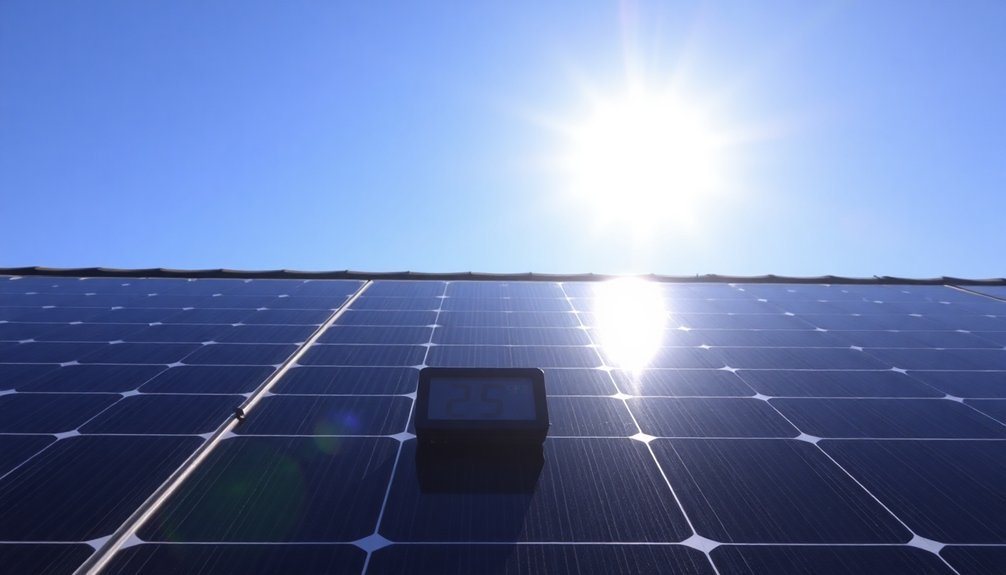
While many people think of sunlight as constant throughout the day, peak sun hours tell a different story. During these periods, solar radiation reaches its maximum intensity of about 1,000 kWh/m^2, typically occurring between 10 a.m. and 4 p.m.
You'll find the most intense sunlight around solar noon, when the sun reaches its highest point in your sky. However, this doesn't always match your clock's noon time.
Peak sun hours are essential if you're planning to use solar energy, as they directly affect how much power you can generate. Local weather conditions can significantly impact energy output, with cloudy days reducing solar panel efficiency to just 10-25% of normal production.
Your location matters considerably. If you live near the equator, you'll experience more consistent peak sun hours throughout the year.
In contrast, if you're in mid-latitudes, you'll notice dramatic seasonal variations, with longer peak periods in summer and shorter ones in winter.
Optimal Food Preparation Times
You'll find the most efficient cooking times align with peak daylight hours between 10 AM and 2 PM, when solar energy reaches its maximum intensity.
During these ideal hours, you can maintain better temperature control of both hot and cold foods while avoiding the dangerous 40-140°F zone that promotes bacterial growth.
Nature's timing works in your favor, as early preparation lets you serve meals at their peak freshness while taking advantage of natural light for food safety checks. The sun's position directly over the Tropic of Cancer during the summer solstice provides maximum solar exposure for food preparation activities.
Peak Solar Cooking Hours
During the summer solstice, the peak hours for solar cooking extend from 10 a.m. to 4 p.m., with the most intense sunlight occurring between 11 a.m. and 3 p.m. You'll find these hours ideal for baking and complex meal preparation, as the sun's position maximizes UV exposure and solar radiation. Using dark, thin cookware will significantly improve your cooking efficiency during these peak hours.
| Time of Day | Best Uses |
|---|---|
| 9-10 AM | Preheating, prep work |
| 10-11 AM | Slow-cooking starts |
| 11 AM-1 PM | Baking, roasting |
| 1-3 PM | Main course cooking |
| 3-4 PM | Finishing dishes |
To make the most of summer's longest day, start your solar cooking early. You'll need to adjust your cooker's position hourly to follow the sun's path. While winter months limit your cooking window, summer's extended daylight hours let you prepare multiple dishes throughout the day.
Temperature Control For Success
Maintaining precise temperature control stands as the cornerstone of successful food preparation, especially when cooking with solar energy.
Bacteria multiply rapidly in the danger zone temperature between 34°F to 126°F (1°C to 52°C), making proper temperature management crucial.
You'll need to monitor your food's internal temperatures carefully to guarantee both safety and ideal results during the summer's peak sunlight hours.
To maximize your solar cooking success, follow these critical temperature guidelines:
- Keep cold ingredients below 41°F (5°C) until you're ready to cook, preventing dangerous bacterial growth.
- Confirm meat reaches proper internal temperatures – 145°F (62.8°C) for whole cuts and 160°F (71.1°C) for ground meats.
- Monitor your solar oven's temperature, aiming for 329°F (165°C) for most meat dishes.
- Cool any leftovers quickly, bringing them from 135°F to 70°F within two hours to maintain food safety.
Nature's Perfect Timing
As the summer solstice brings longer daylight hours, aligning your food preparation with nature's rhythms can greatly enhance your meal planning efficiency. You'll find this seasonal shift is the perfect time to revamp your meal prep routine and cleanse your diet.
Take advantage of the extended daylight by prepping seasonal produce early in the day. You can blanch summer vegetables for freezing, marinate proteins, and batch-cook grains while maximizing natural light and energy.
During this time, you'll want to increase your water intake and incorporate more fresh, seasonal ingredients into your meals. Cut back on processed foods and stimulants like coffee and chocolate.
Remember to store your prepped ingredients properly – use airtight containers, label everything clearly, and follow refrigeration guidelines to maintain freshness and food safety.
Sun Position and Cooking
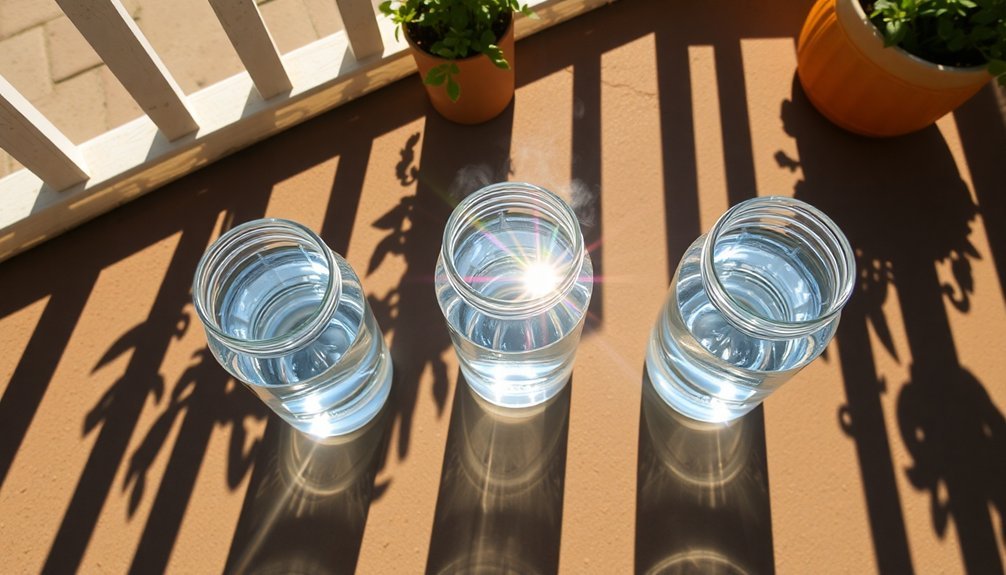
The sun's position plays an essential role in successful solar cooking since direct sunlight provides the most intense heat for your cooker.
You'll get the best results during summer's longest day when the sun reaches its highest point in the sky, delivering maximum solar intensity to your cooking surface.
To maximize your solar cooking efficiency:
- Position your cooker in a spot that'll receive uninterrupted sunlight throughout the cooking period.
- Adjust your cooker's angle to match the sun's position, especially if you're cooking away from the equator.
- Use matte black cookware to enhance heat absorption and retention.
- Realign your cooker every 1-2 hours to follow the sun's path.
The closer you're to the equator, the more consistent your year-round solar cooking results will be, thanks to more direct sunlight.
Temperature Control While Cooking
During summer's peak, you'll need to adjust your cooking temperatures to account for the naturally warmer kitchen environment, often requiring lower heat settings than usual on your stovetop.
You can harness the intense summer sunlight by positioning your cooking setup near bright windows, which helps maintain steady temperatures while reducing energy consumption.
When the sun reaches its highest point on the solstice, you're in a prime position to experiment with solar cooking methods, from sun-warmed prep stations to solar ovens that capitalize on the season's abundant natural heat.
Seasonal Heat Impacts Cooking
Since summer's heat noticeably affects cooking temperatures, understanding how to control and adjust your cooking methods becomes vital for ideal results.
High temperatures and direct sunlight can greatly impact your cooking times, while humidity levels play an important role in how quickly food cooks.
To maintain ideal cooking conditions during summer, you'll need to:
- Monitor humidity levels closely, as high humidity reduces moisture evaporation and speeds up cooking
- Adjust your cooking times downward on particularly hot days to prevent overcooking
- Use proper ventilation and make-up air to manage kitchen heat effectively
- Match pot sizes to burner sizes and use pot covers to maintain consistent temperatures
You'll find that induction cooking can help keep your kitchen cooler, as it generates heat directly in the pan rather than heating the surrounding air.
Solstice Temperature Control Tips
While mastering temperature control remains vital year-round, summer's peak heat demands extra attention to achieve consistent cooking results. You'll need to adjust your cooking techniques based on specific temperature ranges for ideal results.
| Technique | Temperature | Best For |
|---|---|---|
| Sweating | 285°F | Translucent vegetables |
| Sautéing | 350°F | Quick-cooking ingredients |
| Searing | 430°F | Protein color and texture |
For precision, you'll want to lower heat when sautéing delicate items like garlic and ginger, while maintaining higher temperatures for proteins that need a good sear. Consider using tools like sous vide devices for exact temperature control within 1/10th of a degree. During summer's heat, you'll find that ingredients may cook faster, so it's essential to monitor and adjust temperatures accordingly.
Solar Energy Kitchen Methods
As solar energy transforms modern cooking methods, you'll find that temperature control in solar ovens requires understanding specific components and techniques.
You'll achieve ideal cooking results by monitoring temperatures and adjusting reflectors throughout the day to maximize sun exposure.
For effective temperature management, follow these essential steps:
- Position your reflective surfaces to concentrate sunlight directly onto the cooking chamber.
- Use transparent heat traps like glass bowls or clear plastic bags to maintain consistent temperatures.
- Select appropriate cooking methods based on your oven type – panel cookers for steaming, parabolic designs for high-heat cooking.
- Monitor internal temperatures regularly while allowing for gentle, slow cooking that preserves nutrients.
Best Summer Foods Outside
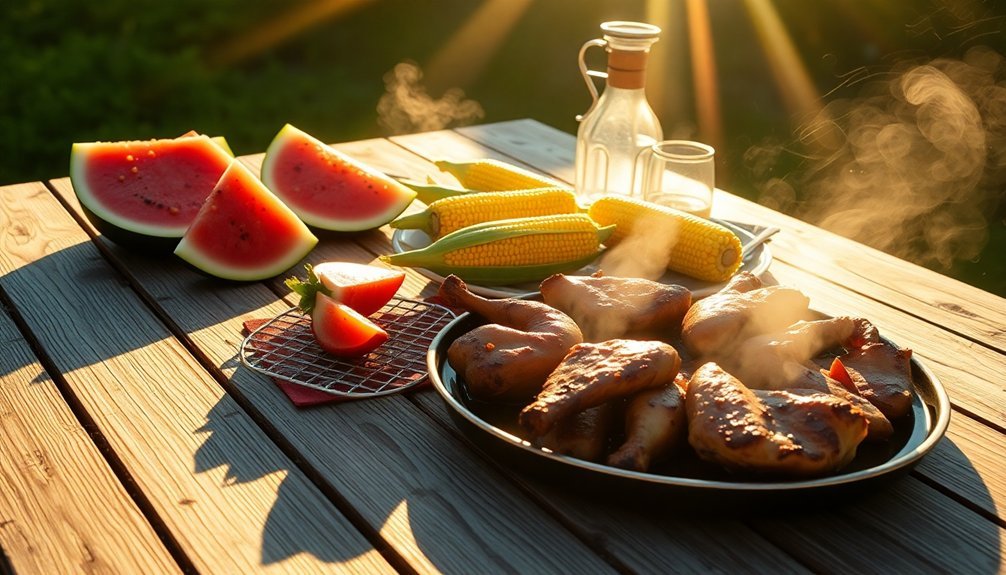
When summer's warm weather beckons you outdoors, nothing beats the joy of cooking and eating in the open air. You'll find endless possibilities, from grilling classic favorites to creating innovative campfire meals.
Try walking tacos with seasoned ground beef and toppings in corn chip bags, or wrap foil packets filled with potatoes and smoked sausage. For a lighter option, skewer shrimp with garlic and lemon, or thread colorful vegetables onto sticks for a balsamic-glazed treat.
Don't forget revitalizing sides like watermelon-feta orzo salad or spicy corn on the cob. For special occasions, you can't go wrong with lemon dill salmon packets or BBQ chicken sliders.
Pair your outdoor feast with a chilled Aperol Spritz, and you've got the perfect summer meal under the sun.
Seasonal Solar Cooking Tips
Taking outdoor cooking to the next level, solar cooking harnesses the sun's energy to prepare delicious meals without fuel or electricity.
During summer's longest days, you'll find peak cooking hours between 11:00 am and 3:00 pm when the sun is directly overhead, providing ideal temperatures for baking and roasting.
To maximize your solar cooking success, follow these essential tips:
- Position your cooker facing the sun with minimal shadows, and adjust it throughout the day to maintain direct exposure.
- Use dark-colored, thin metal cookware with lids to absorb heat efficiently and retain moisture.
- Pre-heat your solar oven starting at 10:00 am to achieve better browning and consistent temperatures.
- Reduce liquid ingredients by ¼ to ½ cup since evaporation is minimal in solar cooking.
Remember to monitor internal temperatures for food safety and protect your cooker from strong winds.
Traditional Solstice Recipes
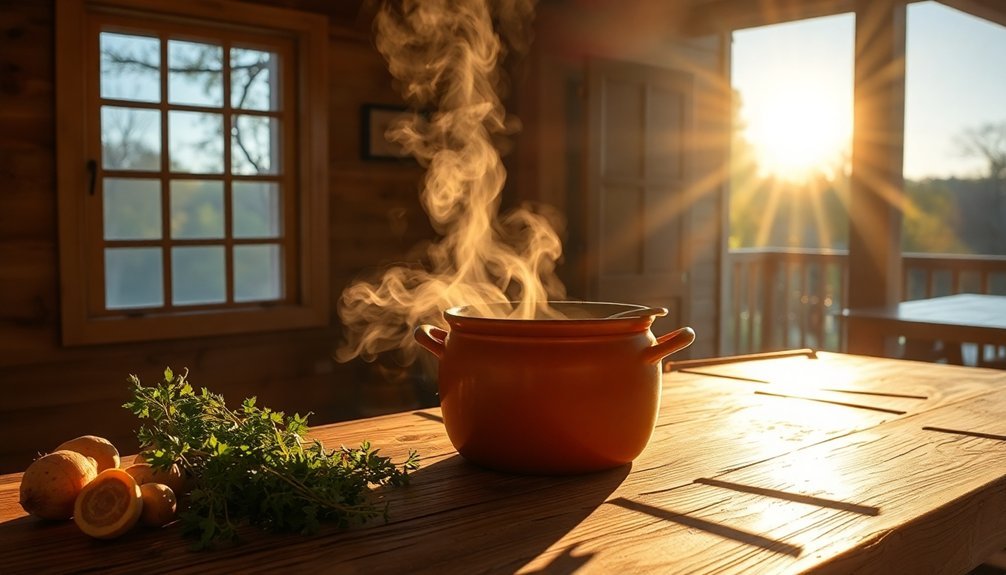
Traditional solstice recipes showcase four distinct categories of hearty comfort foods that have stood the test of time. You'll find warming stews packed with root vegetables, mushroom bisques enriched with cream, and savory chicken and dumplings that perfectly capture the season's essence.
| Main Dishes | Side Items | Special Touches |
|---|---|---|
| Beef Stew | Mashed Potatoes | Star Anise & Ginger |
| Turkey/Chicken | Brussels Sprouts | Herbes de Provence |
| Baked Ham | Root Vegetables | Fresh Herbs |
| Lentil Dishes | Sourdough Bread | Toasted Seeds |
Don't forget the desserts that make solstice celebrations memorable. You can bake a traditional Yule log cake or create fruit-based treats featuring pomegranates and citrus. Add warmth to your baked goods with seasonal spices like cinnamon, ginger, and clove.
Frequently Asked Questions
Can Solar Cooking Affect the Nutritional Content of Food Differently Than Conventional Methods?
Yes, solar cooking affects your food's nutrients differently. You'll retain more vitamins and minerals through gentle heating, but you'll lose more vitamin C compared to conventional methods due to longer cooking times.
How Does Humidity Impact the Effectiveness of Solar Cooking During Summer?
You'll find that high humidity reduces your solar cooking efficiency by scattering sunlight and decreasing radiation intensity. It'll slow down cooking times and lower peak temperatures, requiring longer preheating and adjusted cooking methods.
Which Materials Work Best for Solar Cooking Containers at Different Latitudes?
You'll get best results using dark metal containers at higher latitudes where sunlight's weaker, while lighter aluminum pots work well near the equator. Add thermal mass like thick-bottomed pots for extended cooking times.
Do Air Pollution Levels Affect Solar Cooking Efficiency During Summer Solstice?
Yes, your solar cooking efficiency drops during summer solstice when air pollution is high. You'll notice pollutants like particulate matter and smog scatter sunlight, reducing the direct radiation that reaches your solar cooker's surface.
What Safety Precautions Are Unique to Cooking With Summer Solstice Sunlight?
You'll need UV-protective eyewear and sunscreen when solar cooking. Keep food covered to prevent contamination from insects, and monitor temperatures closely since solar heat can be intense and unpredictable during solstice.
In Summary
You'll find that cooking on summer's longest day gives you peak solar energy and ideal heating conditions for outdoor food preparation. By timing your cooking with the sun's highest position, you're maximizing nature's heating power. Whether you're using a solar oven or traditional grill, you've got more daylight hours to perfect your seasonal dishes. Make the most of this natural advantage by planning your solstice meals accordingly.

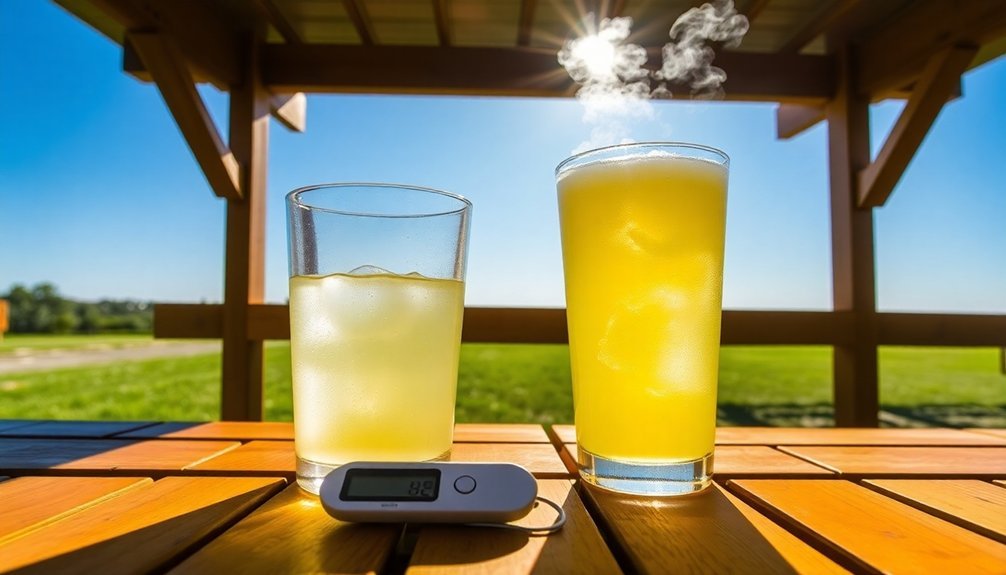



Leave a Reply